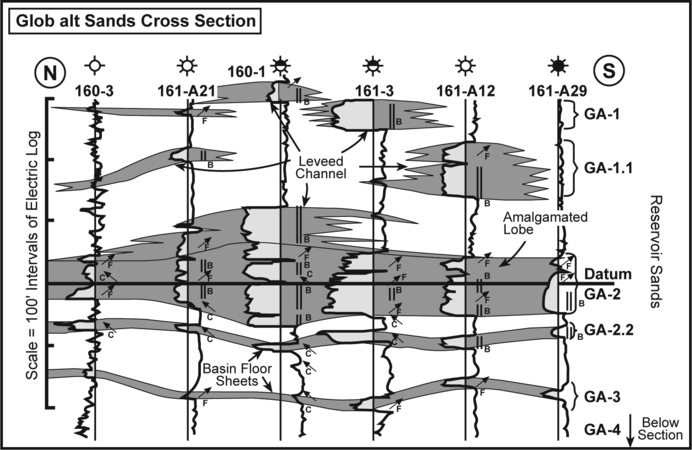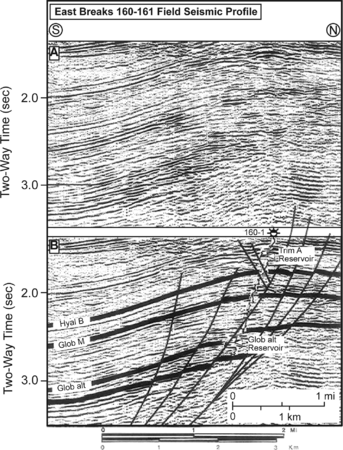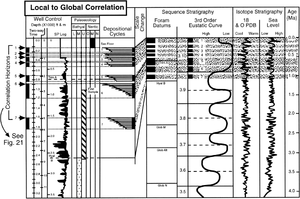East Breaks seal rock
| Exploring for Oil and Gas Traps | |

| |
| Series | Treatise in Petroleum Geology |
|---|---|
| Part | Critical elements of the petroleum system |
| Chapter | Sedimentary basin analysis |
| Author | John M. Armentrout |
| Link | Web page |
| Store | AAPG Store |
Description
Figure 1 Well log cross-section of the Glob alt reservoir interval. After Armentrout et al.;[1] courtesy Springer-Verlag.
Figure 2 Seismic reflection profile showing the Glob alt reservoir interval. After Armentrout et al.;[1] courtesy Springer-Verlag.
The deep-water sands of the Glob alt reservoir are encased in hemipelagic mudstones and have a top seal associated with the condensed section of the Glob alt depositional cycle.[2] The well-log cross section in Figure 1 shows the correlation of the Glob alt sandstones. The top seal, which occurs above the log cross section, is a major mudstone condensed interval coincident with the Glob alt datum labeled on Figure 2. Mudstones older than the condensed section encasing the Glob alt sandstones provide local top seal and lateral seal.
Effectiveness
The top seal of the Glob alt reservoir is especially effective because it is thick and has a regional extent as a consequence of its position at a third-order turnaround from regression to transgression. This turnaround is from regressive cycles 3.4–3.5–3.6 to transgressive cycles 3.7–3.8 on the Haq et al.[3] cycle chart (Figure 3).
Despite its regional extent and thickness, hydrocarbons have leaked upward into the Hyal B and Trim A reservoirs, most probably along faults during intervals of fault movement with consequent dilation of fracture networks along the fault.
Carrier beds and seal evaluation
Impermeable rocks also affect migration pathways. Porous and permeable beds bounded above and below by impermeable rocks can provide highly effective hydrocarbon carrier beds.
See also
- East Breaks petroleum system
- East Breaks reservoir rock
- East Breaks overburden rock
- East Breaks source rock
References
- ↑ 1.0 1.1 Armentrout, J. M., S. J. Malacek, P. Braithwaite, and C. R. Beeman, 1991, Seismic facies of slope basin turbidite reservoirs, East Breaks 160-161 field: Pliocene–Pleistocene, northwestern Gulf of Mexico, in P. Weimer and M. J. Link, eds., Seismic Facies and Sedimentary Processes of Submarine Fans and Turbidite Systems: New York, Springer-Verlag, p. 223–239.
- ↑ Armentrout, J. M., 1991, Paleontological constraints on depositional modeling: examples of integration of biostratigraphy and seismic stratigraphy, Pliocene–Pleistocene, Gulf of Mexico, in P. Weimer, and M. H. Link, eds., Seismic Facies and Sedimentary Processes of Submarine Fans and Turbidite Systems: New York, Springer-Verlag, p. 137–170.
- ↑ 3.0 3.1 Haq, B., Hardenbol, J., Vail, P., R., 1988, Mesozoic and Cenozoic chronostratigraphy and cycles of sea-level change: SEPM Special Publication 42, p. 71–108.
- ↑ Williams, D. F., and D. M. Trainor, 1987, Integrated chemical stratigraphy of deep- water frontier areas of the northern Gulf of Mexico: Proceedings, Gulf Coast Section SEPM 8th Annual Research Conference, p. 151–158.
- ↑ Armentrout, J. M., 1993, Relative seal-level variations and fault-salt response: offshore Texas examples: Proceedings, Gulf Coast Section SEPM 14th Annual Research Conference, p. 1–7.


